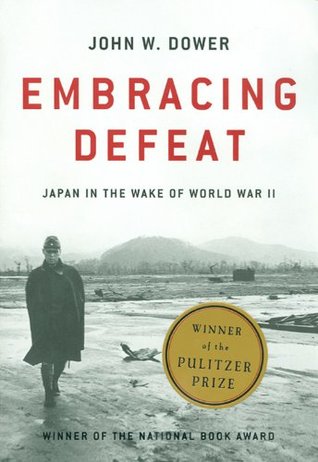More on this book
Community
Kindle Notes & Highlights
Typical diets of desperation also included acorns, orange peels, roots of the arrowroot plant, rice-bran dumplings, and a kind of steamed bread made from a wheat bran that in normal times was fed to horses and cattle.13
Fujin Kurabu (Housewives Club)
“Let’s Catch Grasshoppers.”
one of the most famous phrases of the time: takenoko seikatsu, the “bamboo-shoot existence.”
The edible bamboo shoot can be peeled off in layers, and the takenoko seikatsu phenomenon referred to city people stripping off their clothing, as well as other possessions, for food.
an “onion existence,” with the clear implication of weeping as one peeled off layer upon la...
This highlight has been truncated due to consecutive passage length restrictions.
Hardly a day seems to have passed when food was not a major topic of discussion. Citizens’ groups quickly emerged to protest the government’s miserable delivery system. In this manner, hunger and scarcity served as a stimulus to grass-roots political activism.
By the government’s own standard, an adult needed to consume approximately 2,200 calories a day in order to be able to carry out a light level of activity.
“in today’s Japan, the only people who are not living illegally are those in jail.”
Uneducated people like us cannot understand difficult theories, but I feel there must be enough rice and wheat. Look, if you have the money, five or ten bushels of rice and wheat can be obtained instantly. It’s not that there isn’t any.
wild parsley, rocambole, and fernbrake.
Rabelaisian energy to them. Control of bowels and bladders, for example, often required tactical planning.
Tuberculosis carried off far more victims than all the other diseases combined.
Public discouragement was exacerbated by a recognition that privileged groups continued to prosper in defeat as they had in war.
Alcoholism, never a rarity in male society,
In the greatest moment of crisis in Japanese history, it was a rare officer, official, or executive who devoted himself with sincerity and foresight to serving the well-being of the general populace.
These developments
While some 3.7 million families still lacked housing of their own as of 1948, the government was required to direct a substantial portion of its annual budget to providing housing and facilities for the conquerors—and,
With the “hoarded goods scandal,” structural corruption was established as one foundation stone of the postwar political economy.
no major perpetrators were ever indicted.
By the time of the surrender, much of the most onerous heavy labor—especially in the coal mines—was performed by conscripted Korean laborers or Chinese prisoners.
Millions of them began to consider what it might mean to create a private life free from the dictates of the state.1
a new spirit of iconoclasm and self-reliance.
The sexual implications of having to accommodate hundreds of thousands of Allied servicemen had been terrifying, especially to those who were aware of the rapacity their own forces had exhibited elsewhere as well as of the huge numbers of non-Japanese women who had been forced to serve the imperial troops as ianfu or “comfort women.”
it was taken for granted that the foreigners would demand sexual gratification.
The question was simply: who would provide it?
Enlisting a small number of women to serve as a buffer protecting the chastity of the “good” women of Japan was well-established policy in dealing with Western barbarians.
“we are seeking the active cooperation of new Japanese women to participate in the great task of comforting the occupation force.”
shameless “animalistic intercourse” that showed the “true colors” of so-called American civilization.
The price for a short visit with an R.A.A. prostitute was 15 yen, or one dollar—about the same as half a pack of cigarettes on the Japanese market.
In January 1946, occupation authorities ordered the abolition of all “public” prostitution, declaring it undemocratic and in violation of women’s human rights.
their major motivation was an alarming rise in venereal disease among the troops.
they had “served the country” and been a “dike of chastity,” albeit not their own.
feu-dalistic)
“politics” was the oldest and most unchanged feature of the present-day scene, for it still had no meaningful connection to people’s lives.
“The panpan girls,” Tatsuno responded, “because they have transcended racial and international prejudice.”
the panpan became associated with the liberation of repressed sensuality—a
Their self-indulgent carnality was as sharp a repudiation as could be imagined of the stultifying austerity and discipline the militarists had demanded.
One survey of street women found that many were war orphans, or—virtually as devastating in terms of economic and social security—had no fathers.
argot
Like accomplished courtesans of the past, the panpan also possessed special talents—most notably, in their case, the ability to communicate in a polyglot form of English, a hybrid mix of hooker’s Japanese and the GI’s native tongue that was humorously identified as “panglish.” Getting along in this second language, broken or not, was a skill highly valued in post-surrender Japan—hundreds
The panpan arm in arm with her GI companion, or riding gaily in his jeep, constituted a piercing wound to national pride in general and masculine pride in particular.
Figuratively as well as literally, these tough, animated young women were closer to the Americans than anyone else. No one surpassed them as the harbingers of a hedonistic, materialistic, American-style consumer culture.
The ubiquitous sexuality linking conqueror and conquered had far-reaching ramifications insofar as American perceptions of the defeated nation and its people were concerned.
Nothing was truly sacred any longer, and everything seemed interconnected.
Manga, a humor magazine with a wartime pedigree of brilliant propagandistic articles and illustrations,
argot
congeries


